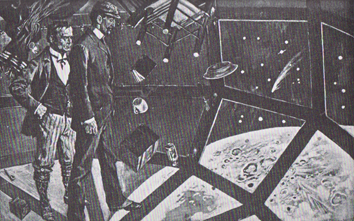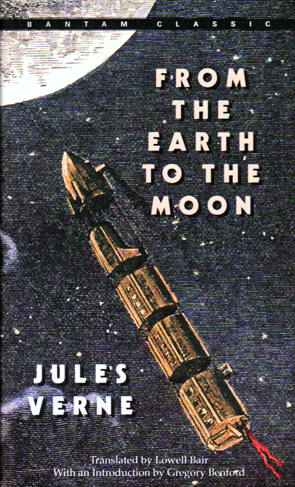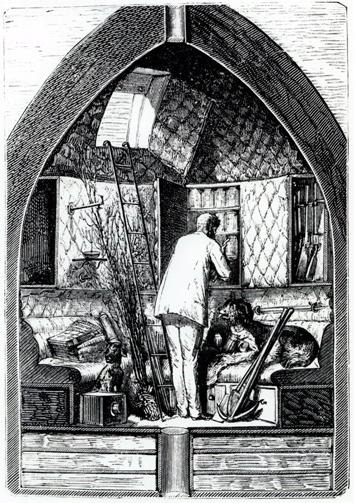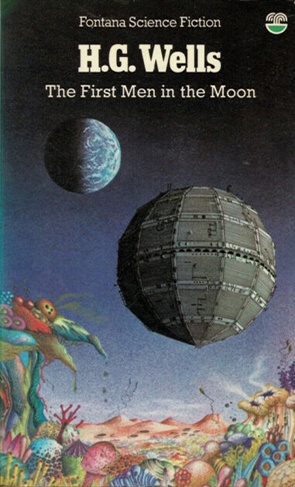H.G. Well’s The First Men in the Moon, published 35 years after Jules Verne’s novel on the same topic, is less ‘science’ and more fiction. While Verne devotes almost the entirety of his first novel about a journey to the moon based upon a theoretical pushing-of-the-limits of the technology developed in the American Civil War, Wells is content to set practical matters aside for the purposes of his narrative and dispense with the overwhelming difficulties of space travel with the invention of Cavorite. Named after its scientific inventor, Mr Carvor, Carvorite is a metal alloy that negates the effects of gravity. When Carvorite is placed between an object and the Earth the effects of gravity are negated. When Carvor first tests his new metal, he destroys his house and its surrounds as they are ripped apart and flung heavenward. With a more cautious approach, and after many months of work with the assistance of the narrator, Mr Bedford, Carvor is able to create a glass sphere with Carvorite panels that can be opened and closed all around the sphere, thereby allowing gravity to act upon the sphere in a controlled manner, or negate its effects. By this means, Carvor reasons, he would be able to use the gravitational forces from the Earth, Moon and Sun to navigate his vessel. It’s easy to judge the difference in Well’s approach by this invention alone. Verne was dismissive of Wells. I make use of physics,
Verne said. He [Wells, of course] invents … Show me this metal. Let him produce it!
Nevertheless, Wells’s Carvorite invention allows the plot to move quickly. Unlike Verne’s three heroes in From the Earth to the Moon, Bedford and Carvor actually make it to the moon, and quite early in the story, too. It’s at this point that differences are again apparent. Whereas Verne knew (and his characters could explain how it was known) that the moon had no atmosphere (or that it had been drawn to the other side of the moon through a denser gravitational pull – Verne was speculating) Wells dispenses with this difficulty as well and describes a moon with life-sustaining oxygen, a luscious growth of plants and a large humanoid race with features likened to ants. Carvor calls them Selenites. One might guess aspects of the plot after this discovery: Bedford and Carvor become separated from their sphere, they are captured by the Selenites, they try to escape and so on.
Wells’s debt to Verne is such that he can’t help but mention him, in the context of a valve that will be fitted to the glass sphere. And Wells chooses a sphere as the transportation device, even though it is somewhat impractical for carrying passengers (and quite unneeded given the properties of Carvorite). Verne’s Barbicane initially has a round projectile in mind before the mission becomes manned because it will be fired from a giant cannon. One wonders, also, whether Wells had Verne’s Journey to the Centre of the Earth in mind when he wrote this book. Verne based that novel on the Hollow Earth Theory that had some currency in the nineteenth century. To be fair, Carvor attributes his knowledge of a theory of a hollow moon to Kepler: Kepler with his subvolvani, was right after all.
(Note: It’s a bit unclear to me what this refers to, even after some looking about on the net, although there is a discussion of it – with some typical angry spats – on this discussion page). Neverthless, like Verne’s novel, there is an ocean at the centre of the moon, and the idea of a hollow moon serves Wells because it explains why no moon civilisation is apparent to Earth telescopes, as well as further characterising the hive-like civilisation of the Selenites.
The differences in approach between Verne and Wells are also apparent through the narrative voice. Verne mostly uses a third-person narrator to cover the many aspects of his mission and to give the novel a satirical edge. Wells, on the other hand, uses Bedford as a first-person narrator, and even has him adopt the pseudonym ‘Wells’ when he publishes his account of the moon voyage. Two things come of this. First, is that Bedford as scientific ingenu allows Wells to avoid the equivocal nature of the ‘science’, even if Bedford expresses doubts about its application. Second, is that it is not too much of a stretch to attribute Bedford’s views with Wells own held beliefs.
This is where Wells’ writing seems most interesting to me, where he gives glimpses into his own thinking. In The Time Machine he touches upon the idea of knowledge and class, while in The Invisible Man he explores the link between morality and consequence. The First Men in the Moon, taken at face value, is something of a light adventure story, somewhat silly but probably entertaining enough. But Bedford’s attitude towards the Selenites recall nineteenth century attitudes towards race and colonialism. Bedford, a bankrupt business man, sees the moon as ripe for exploitation, made more so by the discovery of an abundance of gold. The Selenites, insect-like with bodies evolved by one-sixth the gravity of Earth, are fragile and easily vanquished. Bedford adopts an age-old colonialist position - What a home for our surplus population! Our poor population
- recalling England’s policies of convict transportation to America and Australia. We must annex this moon
he also tells Carvor. This is part of the White Man’s burden.
Kipling’s poem ‘The White Man’s Burden’ is considered a racist assumption that white people had the responsibility to ‘civilise’ other races. By referencing the poem Bedford is assuming a superiority to the Selenites, an assumption that confers responsibility and a right. Yet Carvor perceives a complex class structure developed upon the moon, with technology and intelligences that have superseded those on Earth. That his two characters can articulate these opposing positions demonstrates the futility of simply attributing Bedford’s views to Wells, himself. Yet in 1901, the year in which this story finished its serialisation, Wells wrote in Anticipations of the Reaction and Scientific Progress Upon Human Life and Thought:
And how will the new republic treat the inferior races? How will it deal with the black? how will it deal with the yellow man? how will it tackle that alleged termite in the civilized woodwork, the Jew? Certainly not as races at all. It will aim to establish, and it will at last, though probably only after a second century has passed, establish a world state with a common language and a common rule.
Wells also articulated anti-racist views in later writings.
While Wells might owe at least a little something to the writing of Jules Verne, his influence on future classics is also evident in this novel. Aldous Huxley, for instance, acknowledged Wells as an inspiration for aspects of his own dystopian future in Brave New World. Huxley’s world, in which each individual is grown in bottles for their specific purposes and roles, comes straight from the Selenite society of Wells’ moon. Wells, even anticipates Huxley’s Soma: worker Selenites are drugged and kept asleep so as not to be in the way or cause trouble when they have no social function to perform.
Wells’ science fiction, then, is not much to do with known science of his time. Wells unburdens himself of the complexities that Jules Verne embraces, and understands that his pseudo-science (did he make up that reference to Kepler?) is merely a vehicle for the broader plot and the ideas he wishes his readers to explore. This makes him less a scientific visionary, and more of a moralist. What he has to say, however, as a writer standing apart from the pronouncements of his characters, is somewhat ambiguous, and each reader will decide for themselves where Wells stands on issues of race, his attitudes to poverty and colonialism.

The Whole Area Was a Moon, A Stupendous Simitar Of White Dawn
This 1900 illustration was one of a series of made by E.Hering for the first publication of The First Men in the Moon. It depicts Carvor and Bedford in their glass sphere on their approach to the moon.

 RSS Feed
RSS Feed Facebook
Facebook Instagram
Instagram YouTube
YouTube Subscribe to our Newsletter
Subscribe to our Newsletter







No one has commented yet. Be the first!